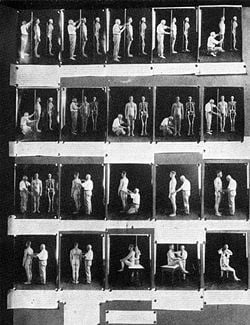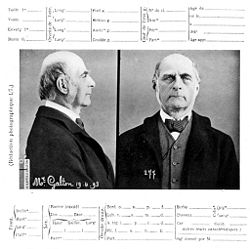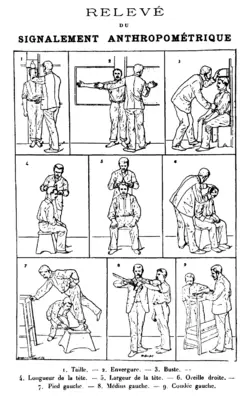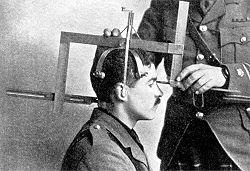Anthropometry
Anthropometry (Greek ανθρωπος, man, and μετρον, measure, literally meaning "measurement of humans"), in physical anthropology, refers to the measurement of living human individuals for the purposes of understanding human physical variation.
Bertillon, Galton, and criminology

The French savant, Alphonse Bertillon (b. 1853), gave this name in 1883 to a system of identification depending on the unchanging character of certain measurements of parts of the human frame. He found by patient inquiry that several physical features and the dimensions of certain bones or bony structures in the body remain practically constant during adult life. He concluded from this that when these measurements were made and recorded systematically every single individual would be found to be perfectly distinguishable from others. The system was soon adapted to police methods, as the immense value of being able to fix a person's identity was fully realized, both in preventing false personation and in bringing home to any one charged with an offence his responsibility for previous wrongdoing. "Bertillonage," as it was called, became widely popular, and after its introduction into France in 1883, where it was soon credited with highly gratifying results, was applied to the administration of justice in most civilized countries. England followed tardily, and it was not until 1894 that an investigation of the methods used and results obtained was made by a special committee sent to Paris for the purpose. It reported favourably, especially on the use of the measurements for primary classification, but recommended also the adoption in part of a system of "finger prints" as suggested by Francis Galton, and already practised in Bengal.
There were eleven measurements:
- Height
- Stretch: Length of body from left shoulder to right middle finger when arm is raised
- Bust: Length of torso from head to seat, taken when seated
- Length of head: Crown to forehead
- Width of head: Temple to temple
- Length of right ear
- Length of left foot
- Length of left middle finger
- Length of left cubit: Elbow to tip of middle finger
- Width of cheeks
- Length of left little finger.
From this great mass of details, soon represented in Paris by the collection of some 100,000 cards, it was possible, proceeding by exhaustion, to sift and sort down the cards till a small bundle of half a dozen produced the combined facts of the measurements of the individual last sought. The whole of the information is easily contained in one cabinet of very ordinary dimensions, and most ingeniously contrived so as to make the most of the space and facilitate the search. The whole of the record is independent of names, and the final identification is by means of the photograph which lies with the individual's card of measurements.
Anthropometrics was first used in the 19th and early 20th century in criminalistics, to identifying criminals by facial characteristics. Francis Galton was a key contributor as well, and it was in showing the redundancy of Bertillon's measurements that he developed the statistical concept of correlation. Bertillon's system originally measured variables he thought were independent—such as forearm length and leg length—but Galton had realized were both the result of a single causal variable (in this case, stature).

Bertillon's goal was to use anthropometry as a way of identifying recidivists—what we would today call "repeat-offense" criminals. Previously, police could only record general descriptions and names, and criminals were fond of using alternative identities. As such, it was a difficult job to identify whether or not certain individuals arrested were "first offenders" or life-long criminals. Photography of criminals had become commonplace but it had proven ungainly, as there was no coherent way to arrange visually the many thousands of photographs in a fashion which would allow easy use (an officer would have to sort through them all with the hope of finding one). Bertillon's hope was that through the use of measurements of the body, all information about the individual criminal could be reduced to a set of identifying numbers which could be entered into a large filing system.
Bertillon also invisioned the system as being organized in such a way that even if the number of measurements was limited the system could drastically reduce the number of potential matches, through an easy system of body parts and characteristics being labeled as "small", "medium", or "large". For example, if the length of the arm was measured and judged to be within the "medium" range, and the size of the foot was known, this would drastically reduce the number of potential records to compare against. With more measurements of hopefully independent variables, a more precise identification could be achieved, which could then be matched against photographic evidence. Certain aspects of this philosophy would also go into Galton's development of fingerprint identification as well.
Anthropometry, however, gradually fell into disfavour, and it has been generally supplanted by the superior system of finger prints. Bertillonage exhibited certain defects which were first brought to light in Bengal. The objections raised were
- the costliness of the instruments employed and their liability to get out of order;
- the need for specially instructed measurers, men of superior education;
- the errors that frequently crept in when carrying out the processes and were all but irremediable.
Measures inaccurately taken, or wrongly read off, could seldom, if ever, be corrected, and these persistent errors defeated all chance of successful search. The process was slow, as it was necessary to repeat it three times so as to arrive at a mean result. In Bengal measurements were already abandoned by 1897, when the finger print system was adopted throughout British India. Three years later England followed suit; and as the result of a fresh inquiry ordered by the Home Office, finger prints were alone relied upon for identification.
Anthropology and anthropometry
During the early 20th century, anthropometry was used extensively by anthropologists in the United States and Europe. One of its primary uses became the attempted differentiation between supposed differences in the races of man, and it was often employed to show ways in which races were supposedly inferior to others. The wide application of intelligence testing also became incorporated into a general anthropometric approach, and many forms of anthropometry were used for the advocacy of eugenics policies. During the 1920s and 1930s, though, members of the school of cultural anthropology of Franz Boas also began to use anthropometric approaches to discredit the concept of fixed biological race. Anthropometric approaches to these types of problems became abandoned in the years after the Holocaust in Nazi Germany, who also famously relied on anthropometric measurements to distinguish "Aryans" from Jews. This school of physical anthropology generally went into decline during the 1940s.
During the 1940s antropometry was used by William Sheldon when evaluating his somatotypes, according to which characteristics of the body can be translated into characteristics of the mind. He also believed that criminality could be predicted according to the body type. This use of antropometry is today also outdated. Because of his extensive reliance on photographs of nude Ivy League students for his work, Sheldon ran into considerable controversy when his work became public.
Modern anthropometry and biometrics
Anthropometric studies are today conducted for numerous different purposes. Academic anthropologists investigate the evolutionary significance of differences in body proportion between populations whose ancestors lived in different environmental settings. Human populations exhibit similar climatic variation patterns to other large-bodied mammals, following Bergmann's rule, which states that individuals in cold climates will tend to be larger than ones in warm climates, and Allen's rule, which states that individuals in cold climates will tend to have shorter, stubbier limbs than those in warm climates. On a microevolutionary level, anthropologists use anthropometric variation to reconstruct small-scale population history. For instance, John Relethford's studies of early twentieth-century anthropometric data from Ireland show that the geographical patterning of body proportions still exhibits traces of the invasions by the English and Norse centuries ago.
Outside academia, scientists working for private companies and government agencies conduct anthropometric studies to determine what range of sizes clothing and other items need to be manufactured in. A basically antropometric division of body types into the categories endomorphic, ectomorphic and mesomorphic derived from Sheldon's somatotypetheories is today popular among people doing weight training.
The US Military has conducted over 40 anthropometric surveys of U.S. Military personnel between 1945 and 1988, including the 1988 Army Anthropometric Survey (ANSUR) of men and women with its 240 measures. Statistical data from these surveys, which encompassed over 75,000 individuals, can be found in DOD-HDBK-743A.
Today people are performing anthropometry with three-dimensional scanners. The subject has a three-dimensional scan taken of their body, and the anthropometrist extracts measurements from the scan rather than directly from the individual. This is beneficial for the anthropometrist in that they can use this scan to extract any measurement at any time.
ReferencesISBN links support NWE through referral fees
- Lombroso, Antropometria di 400 delinquenti (1872)
- Roberts, Manual of Anthropometry (1878)
- Ferri, Studi comparati di antropometria (2 vols., 1881-1882)
- Lombroso, Rughe anomale speciali ai criminali (1890)
- Bertillon, Instructions signalétiques pour l'identification anthropométrique (1893)
- Livi, Anthropometria (Milan, 1900)
- Fürst, Indextabellen zum anthropometrischen Gebrauch (Jena, 1902)
- Report of Home Office Committee on the Best Means of Identifying Habitual Criminals (1893-1894)
- DOD-HDBK-743A, Anthropometry of US Military Personnel (1991)
In art Yves Klein termed anthropometries his performance paintings where he covered nude women with paint, and used their bodies as paintbrushes.
Resources
Books
Bodyspace - Stephen Pheasant - A classic review of human body sizes.
Websites
Credits
New World Encyclopedia writers and editors rewrote and completed the Wikipedia article in accordance with New World Encyclopedia standards. This article abides by terms of the Creative Commons CC-by-sa 3.0 License (CC-by-sa), which may be used and disseminated with proper attribution. Credit is due under the terms of this license that can reference both the New World Encyclopedia contributors and the selfless volunteer contributors of the Wikimedia Foundation. To cite this article click here for a list of acceptable citing formats.The history of earlier contributions by wikipedians is accessible to researchers here:
The history of this article since it was imported to New World Encyclopedia:
Note: Some restrictions may apply to use of individual images which are separately licensed.


